This is the second and final part of a guest post by Abdulhafeez Babatunde Siyanbola, currently a doctoral student in the Department of Industrial Design (Graphic Design Section), Ahmadu Bello University in Nigeria. He is a brand consultant, graphics designer, photography enthusiast and the Creative Director of Craftsentials (an e-commerce site).
You can read the first part of the article by clicking here.

Impacts of Nigeria’s railways
The rail system was instrumental to the further growth in commercial activities in towns located along its corridors. The strides of the colonialists were leveraged by the rail system. The rail sector created jobs for Nigerian workers from different ethnic groups, with a diverse workforce that included West Indians.
It influenced inter-ethnic interactions in areas like: marriage, clothing, foods and language borrowing. In addition, the continued development of the known big cities in Nigeria such as: Lagos, Kano, Kaduna, Zaria, Enugu, Aba, Port Harcourt and others were enhanced by the presence of railway termini in them.
According to statistics on passenger and freight traffics from the NRC, in 1964 the rail system in Nigeria transported 11,288,000 passengers and 2,960,000 tonnes of freight. Ten years later, the figures dropped to 4,342,000 and 1,098,000, respectively (Bisiriyu, 2016).
Problems
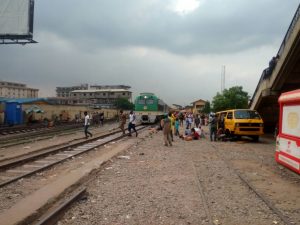
In the 1980s, Nigerian Railway Corporation witnessed reductions in its service provisions, these were influenced by technical and financial shortcomings. However, since the 1960s, the performance of the Nigerian rail system has not been impressive.
The Nigerian civil war depressed railway operations and in the following decade, the low interest in export commodities and coal resulted in reduced freight haulage. The many years of neglect and mismanagement severely hindered the capacity of the rail network from functioning as a means of mass transit.
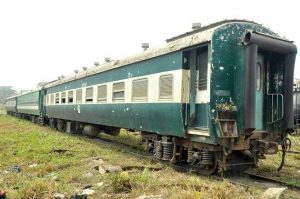
Inept management; complete lack of maintenance; corruption; and bureaucracy also contributed in bringing down the Nigerian rail system to its knees. According to Ikechukwu (2014), the most prominent among other problems plaguing rail transportation in Nigeria are:
- Inefficiency: The Nigerian Railway Corporation is an epitome of inefficiency. Its trains do not keep to scheduled departure and arrival time. Commuter’s luggage often gets missing or tampered with on transit. Commuters in first class coaches do not receive the services promised. Cargoes are usually delayed, stolen and damaged on transit. All these discourage customers from patronizing Nigerian Railway.
- Bureaucracy: Railway organizations are usually very large single organizations which have to be run through a system of laid down rules and regulations (protocols) be rigidly adhered to.
- Low funding on the part of Government: While the government controls the railway corporation in Nigeria, it does not give adequate budgetary allocation to help subsidize the operations of the corporation. In Nigeria, under the second National development plan, only a paltry 2.14% of the public sector development expenditure was allocated for railway development while road development got 10.2% (Nigeria railway corporation, 1990). This low funding of railway development has seriously contributed to its remaining the under-dog of other modes of transportation in Nigeria.
- Problem of marketing myopia: The operators of rail services normally define their market or scope of their business too narrowly. They generally see their business as that of rail transportation rather than that of transportation or transport service. Despite the fact that railway came into being much before modern highway, and ocean transportation and these late comers were attached to railway when they came, railway men generally concentrated their minds and efforts on just the railway. They failed to broaden their scope or develop other facilities related to rail business. They also failed to adopt their railway line to suit other terrains such as mountains and valleys. They confined their services to only those traditional ones which are given in rail transit rather than in transportation. With time, other modes of transportation took away the service opportunities abandoned by railway men (Olakunori, 1999).
- Nepotism and Selfishness: The running of Nigeria’s Railways have been characterised by nepotism and selfishness often demonstrated by successful governments in the choice of individuals that constitute the railway management board and recruitment of staff. Therefore, the efficiency of the railways is consistently watered down due to ineffectiveness of its political managers.
- Patronage of Obsolete Technologies: The protracted problem of Nigerian railway system can also be attributed to the inability of the Federal Government to seek expertise assistance from countries who were the pacesetters in modern railway technologies; ElMammann (n.d) buttress this argument in the following:
Between the year 1960 and the year 2000 the Federal Government of Nigeria (FGN) involved Indian and Chinese companies to undertake the revitalisation and upgrade of the country’s rail system. These efforts failed partly because the FGN decided to reduce costs by inviting companies from countries whose rail system technologies are (were) still in (their) developing phase, compared to Britain and Japan.
The cost of bringing in companies from Britain and Japan will fizzle compared to the enormous waste that resulted from the services it received to date from India and China.
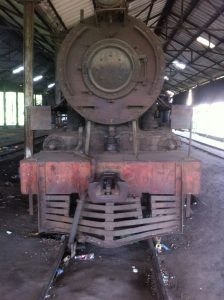
In all fairness to the Chinese and Indian companies, they provided locomotive engines (even though obsolete) that the government was willing to pay for. They provided the technologies that the government was interested in.
An estimated 5,000 kilometres of rail system, 90% of which is not even a standard gauge system is very disheartening and clearly is indicative of the neglect that the rail system had endured for over forty years.
Lack of Political will: The challenges of the railway cannot be divorced from corruption and lack of political will on the part of successive governments who have over the years committed funds to the sector without critically appraising the efforts of previous governments in understanding the actual problems confronting the sector.
Bisiriyu (2016) supported the assertion in the above paragraph with records on how budgetary provisions were made and contracts awarded in the rail sector during Dr. Goodluck Jonathan’s administration below:
In 2013, the Jonathan administration specifically promised to invest N1.6tn in the railway in two years. About 15 different railway projects were pencilled down for completion by 2015. And 13 of the projects were listed for attention in the capital projects of key federal ministries for that year.
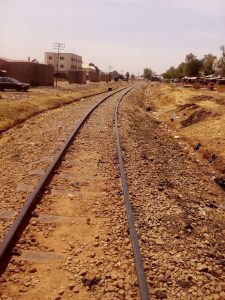
Although the old Lagos-Kano rail line was inaugurated in December 21, 2012, after its rehabilitation it received a vote of N1.4bn in the 2013 budget for maintenance purposes. The breakdown shows the Lagos-Jebba end and Jebba-Kano end received N700m each.
The rehabilitation of the narrow gauge Port Harcourt-Maiduguri line (an ongoing project then) was allocated N67bn; the administration approved N225bn for the construction of a rail line from Aba to Ajaokuta, linking Enugu, Asaba and Agbor.
The government also pledged an initial sum of N48bn for the construction of the 360km rail line from Ajaokuta to Abuja through Jakura and Baro. Similarly, the government voted N5bn for the commencement of the East-West rail line construction, expected to link Lagos to Calabar.
Another long stretch of rail line spanning 650km received N97bn. It is a standard gauge line to cover Lagos, Ife, Ilesha, Owo, Benin, Onitsha and Enugu. It was indicated that about N50.9bn would be spent to construct a 604km rail line linking Zaria-Kaura Namoda-Sokoto and Ilela.
The Abuja mass transit trains Lot 1 & 2 projects received N85.7bn; while the construction of the Abuja light rail received N66.3bn. Six train stations being constructed between Itakpo and Warri were allocated N475.7bn. However, the Centre for Social Justice in its analysis of the developmental projects, faulted the allocation of funds. For instance, it notes a difference of over 50 per cent between what was proposed in the Transformation Agenda for the railway in 2013 and the amount prepared for in that year’s budget.
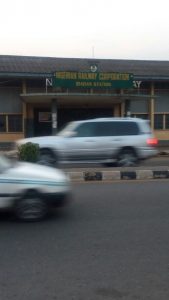
The road networks were created to support the railways, but over time the road system took over in the movement of people and goods. Modal distributions of the country transportation between the rail and road indicate that the railways carried more than 60% of the general tonnage in the 1960s but currently it’s less than 2%.
Osuji (2013) revealed that the highest number of passengers carried was 15.5 million in 1984 and the highest volume of freight was 2.4 million metric tonnes in 1977. He further disclosed that by 2000 to 2001, traffic had fallen to two million passengers and less than 300,000 metric tonnes of freight.
Hence, the rail system in Nigeria accounts for less than one per cent of land transport in the country. The dawning realities of articulated vehicles conveying goods including combustible contents on the roads is an indicator to the failure of the Nigerian rail system.
Apparently, roads are not a viable alternative to railways. The high rate of road related: accidents, crimes, travel time and routine maintenance costs are reflections of the country’s failed rail system and over reliance on road transportation.

Nigeria’s Railways since 2000
In 2006, the Olusegun Obasanjo administration commenced the plan to reconstruct and modernise the Lagos-Kano rail by awarding the project to the China Civil Engineering Construction Corporation (CCECC) at a cost of $8.3 billion. Due to many factors, the project could not commence under the administration. In 2012, the Goodluck Jonathan administration re-awarded the project to the same contractor to be executed in six phases.
In 2013, the Nigerian Railway Corporation added to its capacity by commissioning two new air-conditioned trains and six 68-seater passenger coaches which was expected to increase the daily passenger traffic in Lagos from 16,000 to 22,000.
According to the Managing Director of the NRC, Mr. Adeseyi Sijuwade
the six coaches will be deployed as first class coaches on long distance intercity train services; starting with the Lagos to Kano service. This is meant to increase the number of passengers on the Lagos to Kano service from 6,000 to 7,000.
He added that
the railways move a monthly average of 3,570 tonnes of cement from Ewekoro; 3,170 tonnes of wheat from the Apapa flour mills and 120 bonded containers from the Apapa Port, all the way to Kaduna and Kano. These freight volumes are expected to rise significantly over the next few months.
– Nigeria Trade Hub, 2013
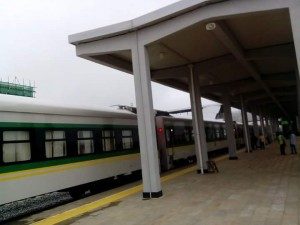
The first high speed Abuja-Kaduna rail was unveiled by Federal Government in July 2016. The project was embarked upon by the Goodluck Jonathan Administration and was completed by Buhari’s Administration. The 186.5km standard gauge track was built by the China Railway Construction Corporation with double lines over a period of three years at the cost of $850m, it has nine stations and the train can travel at up to 150km per hour (Sweeney, 2016)
Sweeney (ibid) disclosed that media reports indicated that the contract was for the design, manufacturing and launching of the locomotives with a capacity of 2,800 kilowatts for standard gauge tracks; the training of 30 NRC personnel on the operation and maintenance of the engines; test-running in Nigeria as well as a one-year maintenance and technical support with two resident technicians from the manufacturers. The 2016 appropriation bill also has in it the construction of a fast-speed Lagos-Calabar and Lagos-Kano railways.
In March 2017, the Vice President of Nigeria, Professor Yemi Osinbajo, who was then acting president performed the ground breaking of the Lagos – Ibadan rail project that is to run from Apapa port in Lagos to Ibadan. This project is the second segment of the planned six segments Lagos to Kano standard gauge rail track. The first of which is the Abuja – Kaduna 187km rail line that was launched in July 2016. Others are the Kaduna – Kano, Ibadan – Ilorin, Minna – Abuja and Ilorin – Minna.
This rail project line will have about eight stations located at Apapa, Ebube-Metta, intermediate stations at Agege, Kajola, Papalanto, Abeokuta, Omi-Adion, a padding station with technical operation. However, it is to be noted that the plan to construct the Lagos-Ibadan Speed Rail Project actually started under the administration of former President Goodluck Jonathan.
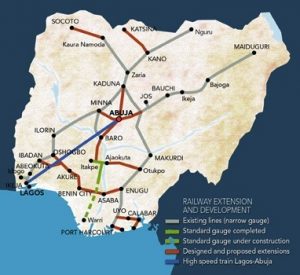
Railways were central to the unity of Nigeria in the early years of its nationhood; various sections of the country are connected by this mode of transportation. In developing Nigeria’s infrastructure to compete with the world’s leading economies, the rail system is key to actualizing such an aspiration.
Hence, the path to unlocking the untapped potentials in the Nigerian economy lies in the revival of rail system and the expansion of its coverage areas. Indeed, the limitless opportunities therein in a vibrant transportation sector in the country are far-reaching and self-sustaining.
Part of this article has been edited by Abdulghaniy Kayode Otukogbe; in order to reflect the recent developments in the Nigerian rail transport sector.
The facts, opinions, views or positions expressed or established in guest posts represent that of the writers and not necessarily of www.edusounds.com.ng.
Please, leave your thoughts on this post in the comment section and feel free to share the article with your contacts. Thanks for taking out of your precious time to read my article/s!
If you like this post, kindly subscribe and/or follow me on Twitter @otukogbe and @EdusoundsNg or on Facebook at edusoundsng.




